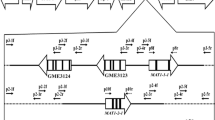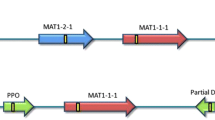Abstract
Sexual reproduction of fungi is governed by genes located on the mating-type (MAT) locus. To analyze the MAT locus of the genus Diaporthe (anamorph: Phomopsis), a large genera within the ascomycetous class Sordariomycetes, we cloned and sequenced loci MAT1-1 and MAT1-2 from two heterothallic Diaporthe species, designated as Diaporthe W- and G-types (four isolates in total). The mating-type loci structures of Diaporthe W- and G-types were similar; MAT1-1 isolates had a MAT locus containing three genes, MAT1-1-1, MAT1-1-2 and MAT1-1-3, as was the case with other Sordariomycetes, and in contrast to other Sordariomycetes, MAT1-2 isolates had genes homologous to MAT1-1-2 and MAT1-1-3, in addition to MAT1-2-1. Expression analysis by RT-PCR revealed that all the mating-type genes of Diaporthe W-type were transcriptionally active during vegetative growth. The structure of MAT loci of Diaporthe W- and G-types is distinct from that in other heterothallic filamentous ascomycetes, which have dissimilar gene structure in opposite mating-type loci. This unique structure is informative to discussing the evolutionary history and function of mating-type genes of Sordariomycete fungi.






Similar content being viewed by others
References
Arie T, Christiansen SK, Yoder OC, Turgeon BG (1997) Efficient cloning of ascomycete mating type genes by PCR amplification of the conserved MAT HMG box. Fungal Genet Biol 21:118–130
Arie T, Kaneko I, Yoshida T, Noguchi M, Nomura Y, Yamaguchi I (2000) Mating -type genes from asexual phytopathogenic ascomycetes Fusarium oxysporum and Alternaria alternata. Mol Plant Microbe Interact 13:1330–1339
Barve MP, Arie T, Salimath SS, Muehlbauer FJ, Peever TL (2003) Cloning and characterization of the mating type(MAT) locus from Ascochyta rabiei (teleomorph:Didymella rabiei) and a MAT phylogeny of legume-associated Ascochyta spp. Fungal Genet Biol 39:151–167
Brayford D (1990) Variation in Phomopsis isolates from Ulmus species in the British Isles and Italy. Mycol Res 94:691–697
Butler G, Kenny C, Fagan A, Kuriischko C, Gaillardin C, Wolfe KH (2004) Evolution of the MAT locus and its HO endonuclease in yeast species. Proc Natl Acad Sci USA 1010:1632–1637
Castlebury LA, Rossman AY, Jaklitsch WJ, Valsilyeva LN (2002) A preliminary overview of the Diaporthales based on large subunit nuclear ribosomal DNA sequences. Mycologia 94:1017–1031
Choi GH, Larson TG, Nuss DL (1992) Molecular analysis of the laccase gene from the chestnut blight fungus and selective suppression of its expression in an isogenic hypovirulenct strain. Mol Plant Microbe Interact 5:119–128
Coppin E, Debuchy R, Alnaise S, Picard M (1997) Mating types and sexual development in filamentous ascomycetes. Microbiol Mol Biol Rev 61:411–428
Debuchy R, Coppin E (1992) The mating types of Podospora anserina: functional analysis and sequence of the fertilization domains. Mol Gen Genet 233:113–121
Debuchy R, Turgeon BG (2006) Mating-type structure, evolution, and function in Euascomycetes. In: Kües U, Fischer R (eds) The Mycota, growth, differentiation and sexuality, 2nd edn. Springer, Berlin, pp 293–323
Debuchy R, Arnaise S, Lecellier G (1993) The mat—allele of Podospora anserina contains three regulatory genes required for the development of fertilized female organs. Mol Gen Genet 241:667–673
Ferreira AVB, Saupe S, Glass NL (1996) Transcriptional analysis of the mtA idiomorph of Neurospora crassa identifies two genes in addition to mtA-1. Mol Gen Genet 250:767–774
Fraser JA, Heitman J (2004) Evolution of fungal sex chromosomes. Mol Microbiol 51:299–306
Glass NL, Grotelueschen J, Metzenberg RL (1990) Neurospora crassa A mating-type region. Proc Natl Acad Sci USA 87:4912–4916
Huelsenbeck JP, Ronquist F (2001) MrBayes: Bayesian inferences of phylogeny. Bioinformatics 17:754–775
Inderbitzin P, Harkness J, Turgeon BG, Berbee ML (2005) Lateral transfer of mating system in Stemphylium. Proc Natl Acad Sci USA 102:11390–11395
Kanematsu S, Kobayashi T, Kudo A, Ohtsu Y (1999) Conidial morphology, pathogenicity and culture characteristics of Phomopsis isolates from peach, Japanese pear and apple in Japan. Ann Phytopathol Soc Jpn 65:264–273
Kanematsu S, Minaka N, Kobayashi T, Kudo A, Ohtsu Y (2000) Molecular phylogenetic analysis of ribosomal DNA internal transcribed spacers and mating tests in Phomopsis isolates from fruit trees. J Gen Plant Pathol 66:191–201
Lahn BT, Page DC (1999) Four evolutionary strata on the human X chromosome. Science 286:964–967
Liu YG, Whittier RF (1995) Thermal asymmetric interlaced PCR: automatable amplification and sequencing of insert end fragments from P1 and YAC clones for chromosome walking. Genomics 25:674–681
Mcguire IC, Marra RE, Turgeon BG, Milgroom MG (2001) Analysis of mating-type genes in the chestnut blight fungus, Cryphonectria parasitica. Fungal Genet Biol 34:131–144
Metzenberg RL, Glass NL (1990) Mating type and mating type strategies in Neurospora. Bioessays 12:53–59
Mostert L, Crous PW, Kang JC, Phillips AJL (2001) Species of Phomospis and a Libertella sp. occurring on grapevines with specific reference to South Africa: morphological, cultural, molecular and pathological characterization. Mycologia 93:146–167
O’Donnell K, Ward TJ, Geiser DM, Kistler HC, Aoki T (2004) Genealogical concordance between the mating type locus and seven other nuclear genes supports formal recognition of nine phylogenetically disticnt species within the Fusarium graminearum clade. Fungal Genet Biol 41:600–623
Paoletti M, Buck KW, Brasier CM (2005a) Cloning and sequence analysis of the MAT-B(MAT-2) genes from the three Dutch elm disease pathogens, Ophiostoma ulmi, O. novo-ulmi, and O. himal-ulmi. Mycol Res 109:983–991
Paoletti M et al (2005b) Evidence for sexuality in the opportunistic fungal pathogen Aspergillus fumigatus. Curr Biol 15:1242–1248
Pöggeler S (1999) Phylogenetic relationships between mating-type sequences from homothallic and heterohtallic ascomycetes. Curr Genet 36:222–231
Sambrook J, Fritsch EF, Maniatis T (1989) Molecular cloning: a laboratory manual, 2nd edn. Cold Spring Harbor Laboratory, Cold Spring Harbor
Staben C, Yanofsky C (1990) Neurospora crassa a mating-type region. Proc Natl Acad Sci USA 87:4917–4921
Turgeon BG (1998) Application of mating type gene technology to problems in fungal biology. Ann Rev Phytopathol 36:115–137
Turgeon BG, Yoder OC (2000) Proposed nomenclature for mating type genes of filamentous ascomycetes. Fungal Genet Biol 31:1–5
Uecker FA (1988) A world list of Phomopsis names with notes on nomenclature, morphology and biology. Cramer Publishers, Berlin, pp 1–231
Van der Aa HA, Noordeloos ME, Gruyter JD (1990) Species concepts in some larger genera of the coelomycetes. Stud Mycol 32:3–19
van Niekerk JM, Groenewald JZ, Farr DF, Fourie PH, Halleen F, Crous PW (2005) Reassessment of Phomopsis species on grapevines. Australas Plant Pathol 34:27–39
Wehmeyer LE (1933) The genus Diaporthe Nitschke and its segregates. University of Michigan Press, Ann Arbor, pp 1–349
Yamagishi K, Kimura T, Suzuki M, Shinmoto H (2002) Suppression of fruit-body formation by constitutively active G-protein α-subunits ScGP-A and ScGP-C in the homobasidiomycete Schizophyllum commune. Microbiol 148:2729–2809
Yokoyama E, Yamagishi K, Hara A (2003) Structure of the mating-type loci of Cordyceps takaomontana. Appl Environ Microbiol 69:5019–5022
Yun SH, Berbee ML, Yoder OC, Turgeon BG (1999) Evolution of the fungal self-fertile reproductive life style from self-sterile ancestors. Proc Natl Acad Sci USA 96:5592–5597
Yun SH, Arie T, Kaneko I, Yoder OC, Turgeon BG (2000) Molecular organization of mating type loci in heterothallic, homothallic and asexual Giberella/Fusarium species. Fungal Genet Biol 31:7–20
Zhang AW, Riccioni L, Pedersen WL, Kollipara KP, Hartman GL (1998) Molecular identification and phylogenetic grouping of Diaporthe phaseolorum and Phomopsis longicolla isolates from soybean. Phytopathol 88:1306–1314
Acknowledgments
We are grateful to Dr. N. Matsumoto for critical review of this manuscript, and Dr. T. Arie for poviding the primers NcHMG1 and NcHMG2. This study was supported in part by a Grant-in-Aid (Bio Design Program) from the Ministry of Agriculture, Forestry and Fisheries of Japan.
Author information
Authors and Affiliations
Corresponding author
Additional information
Communicated by U. Kück.
Rights and permissions
About this article
Cite this article
Kanematsu, S., Adachi, Y. & Ito, T. Mating-type loci of heterothallic Diaporthe spp.: homologous genes are present in opposite mating-types. Curr Genet 52, 11–22 (2007). https://doi.org/10.1007/s00294-007-0132-3
Received:
Revised:
Accepted:
Published:
Issue Date:
DOI: https://doi.org/10.1007/s00294-007-0132-3




